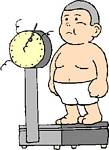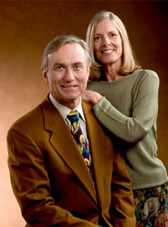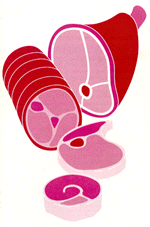Roger J. Wendell
Defending 3.8 Billion Years of Organic EvolutionSM



|
Diet Although I'm not a doctor I've studied dieting, to a great extent, because of my own battle(s) with weight control and other health issues. So, whenever I run across what I believe to be some good dieting tips, I post 'em here. Of course, I always gain the author's permission before reproducing any of their work at length. Also, I always ask that folks check with their doctor before making any changes to their own diet... |
|
Why eating a lot feels so darn goodBy Madison Park, CNN by Madison Park, CNN, November 24, 2010 "Having a belly stuffed with comforting food can feel like a warm hug from the inside. "Evolution has given us the instinct to eat a lot every time we can, preparing for hard times. It's the drive to survive, like puffy-cheeked squirrels storing up for the winter. It's also fueled by competition: beating the others to the food. "Our brains reward us for it, by releasing pleasure chemicals -- in the same way as drugs and alcohol, experts say. "Scientists studying that good feeling after eating call it ingestion analgesia, literally pain relief from eating." |
Some Solutions:
"Eat food. Not too much. Mostly plants." "That's it. That is the short answer to the supposedly incredibly complicated and confusing question of what we humans should eat in order to be maximally healthy..." - In Defense of Food author Michael Pollan in an 01-01-2008 interview with Steve Inskeep on NPR's Morning Edition
"Most overweight people will lose about ten pounds per month on a starch-centered diet. This weight loss stops when a trim body weight is attained. If you are not losing weight quickly enough, you should center your diet around the lower-calorie starches such as squash, potatoes, corn, and yams."
- John A. McDougall, M.D. & Mary A. McDougall
from their book, The McDougall Plan, p. 27.
Starch: The Traditional Diet of People
John A. McDougall, MD and Mary McDougall
from Chapter 1 of their book, The Starch Solution, p.3

|
"Have you had your rice today?
This Chinese greeting - the equivalent of our how are you? - reminds us that, for the Chinese, whether you've eaten rice is the ultimate measure of well-being. Rice is that essential to the Chinese diet. Throughout most of Asia, the average person eats rice two to three times daily. Rice is also an important food in the Middle East, Latin America, Italy, and the West Indies. After corn it is the second most produced food worldwide, and the world's single most important source of energy, providing more than 20 percent of calories consumed by humans around the globe." "In China, the word for rice and food are one and the same. Likewise, in Japan the word for cooked rice also means 'meal.' Buddhists refer to grains of rice as 'little Buddhas,' while in Thailand the call that brings the family to the table is 'Eat rice.' In India, the first food a new bride offers her husband is not cake but rice. It is also the first solid food that will be offered to her baby. "The story is the same the world over. Whether rice in Asia, potatoes in South America, corn in Central America, wheat in Europe, or beans, millet, sweet potatoes, and barley around the globe, starch has been at the center of food and nutrition throughout human history." |
Northwestern Mutual Financial Network has this to
say about diet on their Longevity Game website:
A good diet is a key to good health. Follow this daily goal:Read meat and junk foods raise cholesterol and contributes
- 5 or more servings of colorful fruits and vegetables
- Limit the amount of red meat and saturated fat
to heart disease. Vegetables, fruits, whole-grain breads
and cereals don't contain cholesterol and saturated fats
and have cancer and heart-disease fighting nutrients.

|
Click Here for my page on food... |

|
Click Here for my page on vegetarianism... |
-The Journal of Health & Healing
Volume 27, Number 3, 2007 p. 6

|
"Eventually, we need some kind of worldwide movement for more vegetarianism, to check those beef farms, poultry farms, fisheries and shrimp,..." "One plate of shrimp, too many lives,..."
(From a visit HH paid to a Washington DC homeless shelter in December, 2007) |

|
HIGH-PROTEIN DIETS - ARE YOU LOSING MORE THAN WEIGHT? By Monique N. Gilbert, B.Sc. |
Protein is a vital nutrient, essential to your health. In its purest form, protein consists of chains of amino acids. There are 22 amino acids that combine to form different proteins, and 8 of these must come from the foods we eat. Our body uses these amino acids to create muscles, blood, skin, hair, nails and internal organs. Proteins help replace and form new tissue, transports oxygen and nutrients in our blood and cells, regulates the balance of water and acids, and is needed to make antibodies. However, too much of a good thing may not be so good for you. Many people are putting their health at risk by eating to much protein. Excessive protein consumption, particularly animal protein, can result in heart disease, stroke, osteoporosis, and kidney stones. As important as protein is for our body, there are many misconceptions about how much we really need in our diet, and the best way to obtain it.The average American eats about twice as much protein than what is actually required. Some people, in the pursuit of thinness, are going on high-protein diets and are eating up to four times the amount of protein that their body needs. Protein deficiency is certainly not a problem in America. So exactly how much protein does your body really need? Much less than you think. According to the American Heart Association and the National Institutes of Health, as little as 50-60 grams of protein a day is enough for most adults. This breaks down to about 10-12% of total calories. Your body only needs 0.36 grams of protein per pound of body weight. To calculate the exact amount you need, multiply your ideal weight by 0.36. This will give you your optimum daily protein requirement in grams. Since the amount of protein needed depends on the amount of lean body mass and not fat, ideal weight is used instead of actual weight. Infants, children, pregnant and nursing women require more protein.
People on high-protein diets are consuming up to 34% of their total calories in the form of protein and up to 53% of total calories from fat. Most of these people are unaware of the amount of protein and fat that is contained in the foods they eat. For instance, a typical 3-ounce beef hamburger, which is small by American standards, contains about 22 grams of protein and 20 grams of fat. You achieve quick weight loss on these diets because of this high fat content. High fat foods give you the sensation of feeling full, faster, so you end up eating fewer total calories. However, this type of protein and fat combination is not the healthiest. Animal proteins are loaded with cholesterol and saturated fat. Many people on these diets also experience an elevation in their LDL (the bad) cholesterol when they remain on this diet for long periods. High levels of LDL cholesterol in the blood clog arteries and is the chief culprit in heart disease, particularly heart attack and stroke. So while you may lose weight in the short-run, you are putting your cardiovascular health in jeopardy in the long-run.
Another reason weight loss is achieved on these high-protein diets, at least temporarily, is actually due to water loss. The increase in the amount of protein consumed, especially from meat and dairy products, raises the levels of uric acid and urea in the blood. These are toxic by-products of protein breakdown and metabolism. The body eliminates this uric acid and urea by pumping lots of water into the kidneys and urinary tract to help it flush out. However, a detrimental side effect of this diuretic response is the loss of essential minerals from the body, including calcium. The high intake of protein leaches calcium from the bones, which leads to osteoporosis.
Medical evidence shows that the body loses an average of 1.75 milligrams of calcium in the urine for every 1 gram increase in animal protein ingested. Additionally, as calcium and other minerals are leached from our bones, they are deposited in the kidneys and can form into painful kidney stones. If a kidney stone becomes large enough to cause a blockage, it stops the flow of urine from the kidney and must be removed by surgery or other methods.
Plant-based proteins, like that found in soy, lowers LDL cholesterol and raises HDL (the good) cholesterol. This prevents the build up of arterial plaque which leads to atherosclerosis (hardening of the arteries) and heart disease, thus reducing the risk heart attack and stroke. The amount and type of protein in your diet also has an important impact on calcium absorption and excretion. Vegetable-protein diets enhance calcium retention in the body and results in less excretion of calcium in the urine. This reduces the risk of osteoporosis and kidney problems. Interestingly, kidney disease is far less common in people who eat a vegetable-based diet than it is in people who eat an animal-based diet. By replacing animal protein with vegetable protein and replacing saturated fat with unsaturated fat, like that found in olive and canola oils, you can avoid the pitfalls of the typical high-protein diet. You will be able to improve your health and regulate your weight while enjoying a vast array of delicious, nutritionally dense, high fiber foods. Remember, eat everything in moderation and nothing in excess. Also, the only healthy way to achieve permanent weight loss is to burn more calories than you take in.
Copyright © Monique N. Gilbert - All Rights Reserved.
Monique N. Gilbert is a certified Personal Trainer/Fitness Counselor, health advocate, Recipe Developer and Soy Food Connoisseur. She began a whole grain, vegetable-rich diet in the mid-1970's. This introduced her to a healthier way of eating and became the foundation of her dietary choices as an adult. She became a full-fledged vegetarian on Earth Day 1990. Monique has wrritten the book Virtues of Soy: A Practical Health Guide and Cookbook and can be reched at: monique@chef.net
Tofu Cream Cheese
Want a heart-healthy cholesterol-free
alternative to cream cheese? Then try
this incredibly delicious dairy-free recipe:
________________________________________________________________________________________
- 5.3 ounces tofu (1/3 of a 16-ounce block firm tofu)
- 1 tablespoon soymilk
- 2 tablespoons canola oil
- 1 teaspoon sugar
- 1/2 teaspoon salt
- 1/2 teaspoon lemon juice
- In a food processor, blend tofu, soymilk and canola oil until it forms a paste. Then add salt, sugar and lemon juice. Blend for a full 1-2 minutes, or until it's creamy smooth.
- Transfer to a container and chill. Use instead of regular cream cheese.
Makes about 3/4 cup (7 ounces)This recipe is from Monique N. Gilbert's book Virtues of Soy:
A Practical Health Guide and Cookbook" (Universal Publishers, 2001, pp. 88-89).

Dr. Robert Atkins
(This portion of the web page returns to
the opinions of me, Roger Wendell...)
On Tuesday, February 10, 2004 (11:38 AM), www.CNN.com posted
an AP article titled: Diet guru Atkins qualified as obese
Dr. Robert Atkins died at age 72, in April 2003, after an injury from falling on
an icy street. Many believe, including me, that the diet he advocated was not only
unhealthy, but contributed to his own health problems as well.In the article, the AP stated, "Dr. Robert Atkins, whose popular diet stresses
protein-rich meat and cheese over carbohydrates, weighed 258 pounds at his death
and had a history of heart disease, a newspaper reported Tuesday."The article went on to say that, "At 258 pounds, the 6-foot-tall Atkins would have
qualified as obese, according to the Centers for Disease Control and Prevention's
body-mass index calculator."However, the article referred to Stuart Trager, chairman of the Atkins Physicians
Council in New York. The article stated thay "...[Atkins'] heart disease stemmed
from cardiomyopathy, a condition thought to result from a viral infection." Mr. Trager
also said that Dr. experienced most of his weight gain after the accident - prior to
that he weighed under 200 lbs.

Weight Watchers Points Calculator
Note: I don't know a thing about Weight Watchers (other than having watched other people undertake the program) so
you really need to investigate the matter before using this calculator or creating a program for yourself. That being
said, you might ask why I'd post such a thing on my site? Well, for one thing it might be a handy reference for friends
and family involved in the program (although I have no idea if this particular calculator is very accurate or not!). For
another, I've also liked simple formulas and computer script/programs and found it fun to play with this on my page!
Just for me!
In March 2010 I found a suggestion from Dr. Neal
Barnard saying that a vegan, plant-based diet is
best. From that, I tried to develop some general
rules to help with my own diet struggles:More of these:
No Nos:
- Oatmeal
- Fruit
- Beans
- Yams
- Sweet Potaotes
- Brocali
- Barley
- Beans
- No cheese
- No dairy
- Avoid all oils
- Avoid salt
- No hydrogenated
- Keep all fats low


|
Links: |
|
|
Other Articles:
 Back to my vegetarianism page...
Back to my vegetarianism page...

 Back to Roger J. Wendell's Home Page...
Back to Roger J. Wendell's Home Page...
Abbey |
About |
Blog |
Contacting
Me |
Copyright |
Disclaimer |
Donate |
Guest
Book |
Home |
Links |
Site
Index |
Solutions |
Terms,
Conditions
and
Fair
Use |
What's
Changed
or
New?
Copyright
© 1955 -